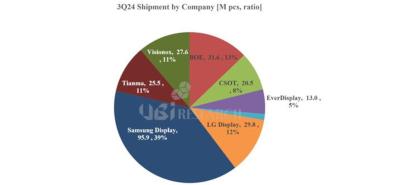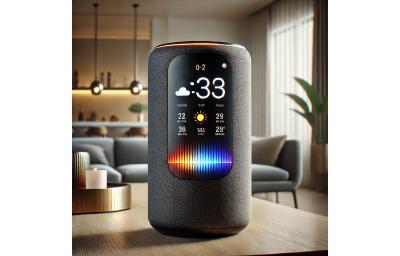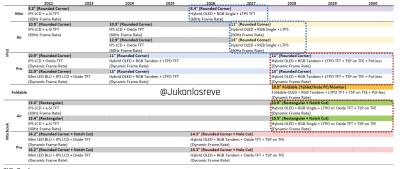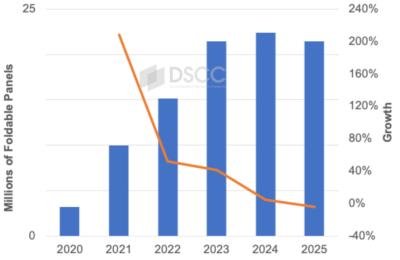Apple: OLED company spotlight
OLED is a new display technology, used to create thin, power efficient and bright displays. Today OLEDs are used in mobile phones, tablets, digital cameras and even TV sets - as OLEDs are considered the best display technology ever.
Apple's OLED devices
Apple's 10th anniversary iPhone X was the company's first OLED Phone - with a 5.8" 1125x2436 (458 PPI) flexible Super AMOLED display. Since then Apple has been adding more OLED iPhones, and starting in 2021, the company's entire smartphone lineup adopts AMOLED displays.
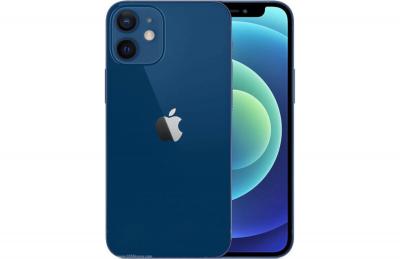
In April 2015 Apple launched its first wearable device, the Apple Watch which used a flexible AMOLED display (made by LG Display). All Apple Watch products to date continue to use flexible AMOLED displays. OLED displays are especially suitable for wearable devices - as the displays are thinner and lighter than LCD displays, and are more power efficient (especially if you tweak the UI to suit the special OLED properties).
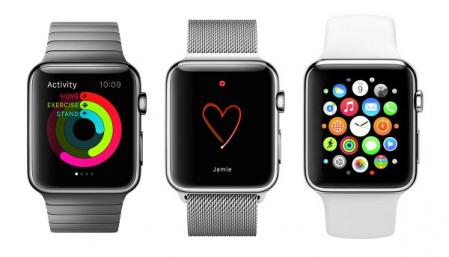
In 2024 Apple launched its first OLED tablets, the 2024 iPad Pro devices, There are two devices, a 11" model (1668x2420) and a 13" model (2064x2752). Both OLEDs offer 120Hz and 1600 nits peak brightness - and a tandem architecture. Apple brands these displays as Ultra Retina Tandem OLEDs.
Apple also has other OLED devices. The Vision Pro VR headset uses 1.4" 4K OLED microdisplays (produced by Sony). In 2016, the company released its MacBook Pro range of high-end laptops that had an OLED Touch Bar instead of the traditional function keys. The company's latest laptops, though, no longer uses this OLED panel.
Reports suggest quality issues at BOE may shift iPhone OLED orders to Samsung Display and LG Display
Sources in Korea suggest that BOE struggles with supplying AMOLED panels to Apple's iPhone, and Apple may switch some of its orders to LG Display and Samsung Display.
BOE is supplying LTPS AMOLED displays to Apple's iPhone 14, 15 and 16 devices, but the company faces quality issues and Apple has rejected many of its displays. It is estimated that it will take at least 6 weeks for BOE to fix the OLED quality problems, and meanwhile since the beginning of 2024 it managed to ship only about 7-8 million panels to Apple - from orders of around 40 million units.
LG Display to retrofit its iPad AMOLED line to produce iPhone OLEDs as Apple reduces its tablet display orders
In late 2024 we reported several times that demand for Apple's iPad Pro devices is lower than expected, and the company reduced its OLED panel orders from both Samsung and LG.
According to a new report from Korea, LG may decide to start using its IT AMOLED production line to produce smartphone displays. The company looks to supply 70 million iPhone AMOLED displays to Apple in 2025, up from around 65 million in 2024 (and 52 million in 2023). Converting the IT AMOLED line to smartphone panel production will enable LGD to increase capacity without a large investment in new equipment.
UBI Research: the OLED emitter market reaches a new high in Q3 2024
UBI Research estimates that the volume of OLED emitting materials purchased in Q3 2024 reached 32.7 tons, which is the highest ever, with the previous record in 2021. UBI expects 2024 as a whole to be the record year in OLED emitter material shipments.
In terms of customers, SDC holds the largest share with 41.4% of the total market, followed by LGD (20.5%), BOE (11.6%) and Visionox (8.3%). In terms of architecture, 83.7% of all emitter materials went into RGB OLEDs, 11.3% into WOLED (LG's WRGB) panels and 2.8% into QD-OLED panels.
UBI: OLED shipments increase in Q3 2024, mostly driven by increased shipments by LG Display and Everdisplay
UBI Research says that shipments of small OLED panels rose to 247 million units, up 7.8% from the previous quarter (and up 32.6% from Q3 2023), mainly driven by increase in shipments by LG Display and Everdisplay.
LG Display shipped 17.6 million smartphones panels in the quarter, up 64% from Q2 and 12.2 million wearable OLED panels (up 147%) - thanks to strong shipments to Apple. In total LGD's AMOLED shipments grew 74% quarter to quarter, and 115% from last year. UBI expects LGD to continue and increase its shipments in Q4. The company is almost at full capacity and UBI says the company may decide to expand the capacity at one of its existing 6-Gen fabs.
Will Tianma exclusively supply OLED displays for Apple's next-generation HomePod device?
There is an interesting (but unverified) report out of Korea that Apple has chosen Tianma to be its exclusive OLED display supplier for a next-generation HomePod smart speaker device, the first one with a display. The OLED HomePod will be released in 2025.
Rumors about a HomePod with a display started surfacing last year, then suggesting that the display will be a 7-inch LCD, indeed supplied by Tianma. But these new rumors suggests that Apple has opted for a higher-quality LTPS AMOLED display, sized 6.7-inch.
UBI: Apple reduces its iPad AMOLED orders from Samsung and LG as demand for its tablets is low
UBI Research estimates that Apple suffers from poor demand for its iPad Pro devices, and the company has reduced its orders from LG Display and Samsung Display. We heard signs of that already back in August.
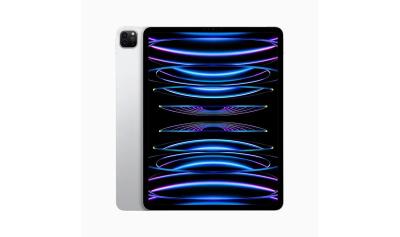
UBI estimates that LG Display's medium to large sized OLED panels shipments decreased 34% in Q3 2024, compared to the previous quarter. Samsung Display's tablet OLED panel sales dropped 38% in the quarter. Samsung however enjoyed higher sales of automotive OLEDs, which means that its entire medium-to-large sales were flat in the quarter.
Omdia updates its Apple laptop and tablet adoption forecast, with new devices arriving in 2026 - and Apple's first foldable laptop by 2028
Omdia has updated its Apple iPad and Macbook display roadmaps, with new forecasts and information about Apple's OLED adoption plans in its IT product lines.
According to Omdia, Apple's iPad Mini will get a 8.4-inch LTPS OLED display in 2026. In 2027, Apple will also introduce OLED displays in its iPad Aid models (11-inch and 13-inch). In 2028 Apple will revamp the OLED displays in its iPad Pro models, offering a tandem architecture, polarizer-free OLED design and LTPO backplanes.
DSCC: The foldable smartphone market will stagnate in 2024 and 2025, fast growth will continue in 2026
According to DSCC, the foldable smartphone display market has declined for the first time in Q3 2024, and the company sees the market entering a flat state in 2024 and 2025. The market has grown fast (at least 40% per year) since 2019, but according to DSCC it will grow only 5% in 2025 and will decline by 4% in 2025. Demand will remain stable at around 22 million units per year.
DSCC says that Samsung is seeing slower than expected demand for its Galaxy Z Flip 6 smartphone, around 10% lower than the Z Flip 5 released in 2023. Almost all of Samsung's demand is in the Korean and Europrean markets. Huawei has also placed lower than expected orders for foldable OLEDs for the second half of 2024, due to the late introduction of the Mate X6 and Pocket 3 devices compared to the 2023 launch dates. The demand for its tri-foldable Mate XT is lower than expected as well.
The US ITC decides that BOE infringes upon Samsung's OLED patent, does not ban panel imports yet
Samsung Display and BOE are fighting a legal battle in the US, as Samsung wishes to halt the import of BOE OLED displays (such as the ones used by Apple in the upcoming iPhone 4 SE smartphone, according to reports) saying that BOE infringes upon Samsung's patents. BOE, meanwhile, together with other OLED makers in China, answered with a motion of their own, to dismiss an SDC AMOLED patent.

The US International Trade Commission (ITC) has now ruled that BOE indeed infringed upon Samsung's OLED patents. However the ITC rejected Samsung's request to ban the import of BOE's displays into the US. Samsung asked to re-examine the decision and the final verdict on issue will be given on March 2025.
Apple reportedly established four new display research labs in China, aiming to expand its OLED supply chain in China
According to industry reports, Apple recently established four display research labs in China, in Beijing, Shenzhen, Suzhou, and Shanghai.
Apple has reportedly formed an alliance with China's leading OLED makers, as the company gets ready to deploy OLED panels in its laptops and tablets. Apple is interested in diversifying its supply chain and not rely exclusively on Samsung Display and LG Display for its smartphone and IT AMOLED panels. The main goal of the new research labs is to test OLED panels produced by Chinese display makers, and evaluate and compare them to LG's and Samsung's OLEDs.
Pagination
- Page 1
- Next page


